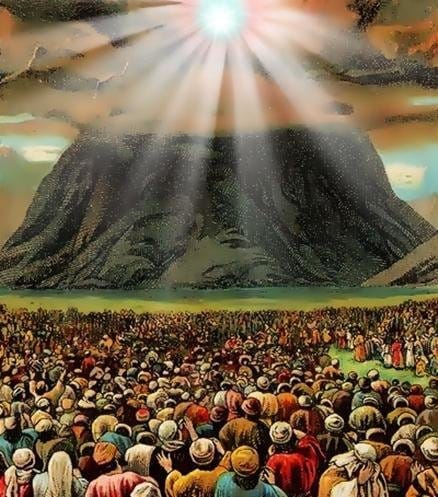No Before and After in the Torah

The Torah is not a modern chronological diary. There is a very famous Hebrew saying: “אֵין מֻקְדָּם וּמְאֻחָר בַּתּוֹרָה” (ein mukdam u-me’uchar ba-Torah) — there is no “before and after” in the Torah.
Events are not always written in neat sequence but arranged in an order that teaches. The purpose is not simply time, but message.
At Sinai, the voice of God thundered. עֲשֶׂרֶת הַדִּבְּרוֹת (Aseret haDibrot) — the Ten Words — were proclaimed directly to Israel (Ex. 20). It was a revelation unlike any in history: the nation trembled, an altar was built, the covenant sealed. And then the people responded with words that still echo: “נַעֲשֶׂה וְנִשְׁמָע” (Na‘aseh ve-nishma) — We will do and we will hear.
For you to understand, it is very much a wedding: the newlyweds would say their “I dos” before they sign the marriage agreement — the vow comes first, the written covenant follows.
This is striking reading the pure Word: Israel stood beneath or under the mountain, like under the Huppah: תַּחְתִּית הָהָר (taḥtit ha-har) — “underneath the mountain” (Ex. 19:17). That is where Paul sees the imagery: “For I betrothed you to one husband, to present you as a pure virgin to Christ” (2 Cor. 11:2)

Moses ascended into the cloud, forty days and nights with God. But down below, time was counted differently. Delay became fear, fear became anxiety, and anxiety turned to the Golden calf. The tablets shattered, intercession followed, the people stood guilty.
And in the middle of all this rises the question: When was the command to build the מִשְׁכָּן (mishkan) given? Was it before or after the calf?
In the Text it appears (Ex. 25) before the sin:
- Law proclaimed (Ex. 20)
- Covenant sealed (Ex. 24)
- 40 days on Sinai – sanctuary instructions (Ex. 25–31)
- Golden calf (Ex. 32)
- Renewed covenant – second tablets (Ex. 33–34)
- Mishkan built (Ex. 35–40)
Yet many sages place it after — as a תִּקּוּן (tikkun), a divine repair: Dwelling of God’s presence is a God's answer to the emptiness they experienced after the goldlen calf terrible event.
Very interesting that E. G. White in Patriarchs and Prophets also places the sanctuary instructions after the calf, as God’s provision and remedy for sin.
- Law proclaimed (Ex. 20)
- Covenant sealed (Ex. 24)
- 40 days on Sinai – Ten Commandments given (Ex. 24:18; 31:18)
- Golden calf (Ex. 32)
- Renewed covenant – second tablets (Ex. 33–34)
- Sanctuary instructions + Mishkan built (Ex. 25–31; 35–40)
The Torah layers these episodes not to confuse us with chronology, but to reveal the rhythm of covenant life: revelation, failure, forgiveness, and dwelling. The Mishkan is not simply architecture — it is God’s embrace after human betrayal, the שְׁכִינָה (Shekhinah) choosing to remain with His forgiven people. It is God's phisical expression of complete reception. Like run, embraces and teas of the father in the progidal son parable. Example for us how to act if you trually forgive.
You see, Moses was not only a prophet, but also a storyteller. He shaped the story as a plot. You do remember the movies, where the order of events is reshuffled. They are called non-linear narrative: starting at the end, jumping back to the middle, circling only later to the beginning. Why? To stir our curiosity, to keep us leaning in, to make us think.
The Torah does the same. It is less about when it happened and more about what it means. Revelation, failure, forgiveness, and dwelling — this is the heartbeat of the covenant. And it is the heartbeat of our own lives too. Our lives are His heartbeat eternally. His 5 sences embrace in Tabernacle is the prove of His faithfulness and love.